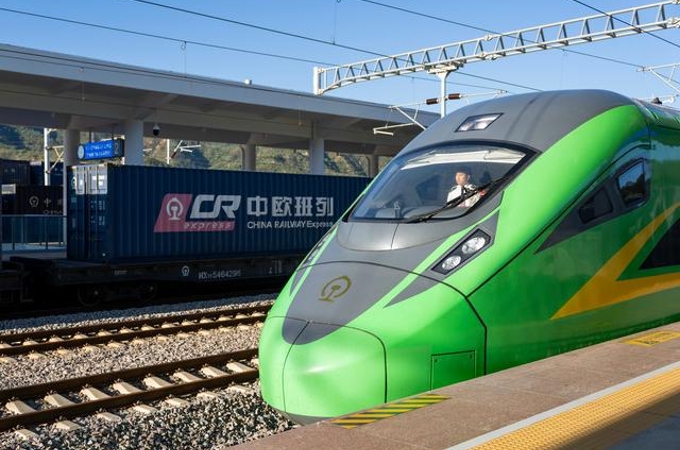Xinjiang aims to soar high as BRI aviation hub
Source: Xinhua | 2023-07-11 | Editor:Lexi
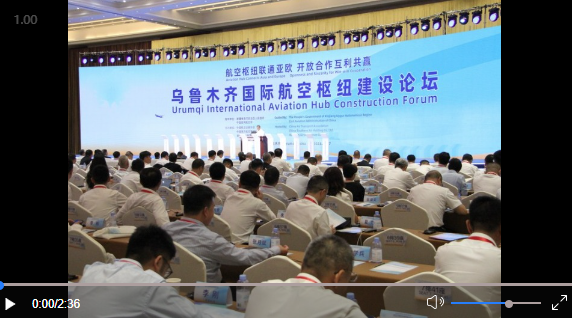
Click here to watch the video>>>
*Over 500 delegates attended the Urumqi International Aviation Hub Construction Forum.
* The Belt and Road Initiative has brought unprecedented opportunities for Xinjiang.
* Airline executives made commitments to support the development of Urumqi as an aviation hub on the Belt and Road.
By Xinhua writers Zhao Chenjie, Liu Hongxia, Pan Ying and Lyu Qiuping
Nailul Husnah, an executive of Garuda Indonesia airline, flew thousands of kilometers to northwest China's Xinjiang Uygur Autonomous Region from Indonesia for the first time. It was a long trip, but also a fruitful one.
"Vast and amazing," she said, marveling at the mountains, canyons, deserts, oases and cities she saw from above after her flight entered Xinjiang.
She went on to add that while her company has yet to launch flights to Xinjiang, it recognizes the vast potential and promising prospects in this region.
Husnah was one of the over 500 delegates attending the Urumqi International Aviation Hub Construction Forum held last week, with the theme "aviation hub connects Asia and Europe, openness and sincerity for win-win cooperation."
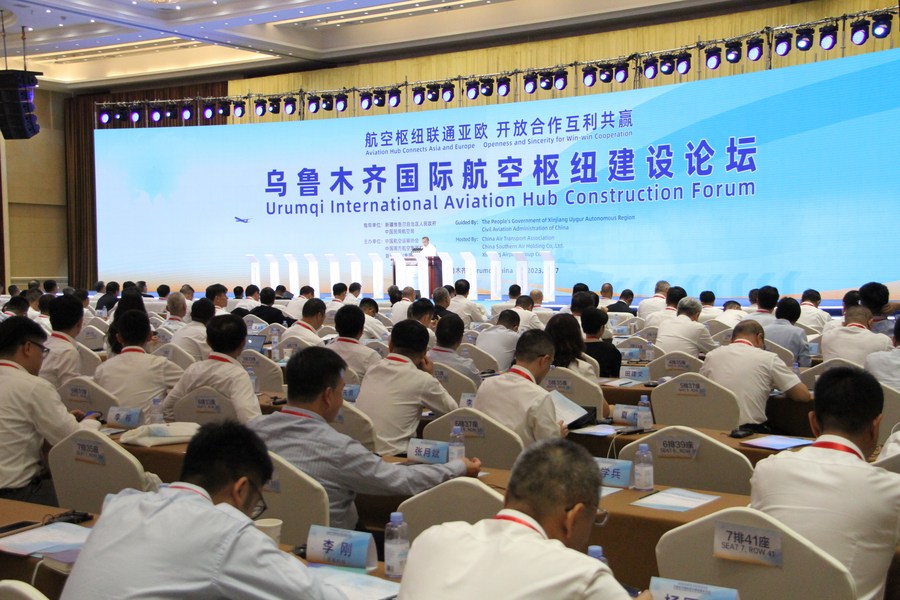
This photo taken on July 6, 2023 shows a scene of the Urumqi International Aviation Hub Construction Forum in Urumqi, northwest China's Xinjiang Uygur Autonomous Region. (Xinhua/Liu Hongxia)
Representatives from major global aviation companies, domestic and foreign civil aviation administrations and airports gathered in the regional capital Urumqi to exchange ideas on developing the civil aviation industry along the Belt and Road.
The Belt and Road Initiative (BRI) proposed by China 10 years ago has brought unprecedented opportunities for Xinjiang, a region located at the heart of the ancient Silk Road.
According to Xinjiang Airport Group Co., Ltd., at present, there are 25 civil transport airports in Xinjiang, topping China's provincial-level regions. It is estimated that the number of airports in use and under construction will reach 33 by the end of 2025.
GATEWAY LINKING EAST, WEST
"Urumqi has great potential to become an important transportation hub," said Alvin Liu, executive vice president of Boeing China, adding that the BRI envisions interconnection and common prosperity, opening a gate for cooperation.
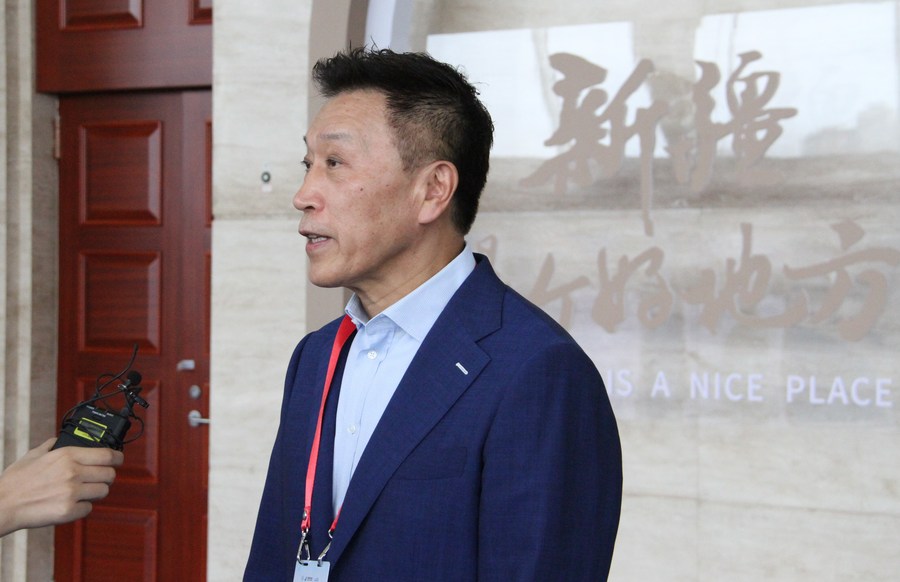
Alvin Liu, executive vice president of Boeing China, speaks during an interview with Xinhua in Urumqi, northwest China's Xinjiang Uygur Autonomous Region, July 6, 2023. (Xinhua/Liu Hongxia)
"We are committed to supporting new air routes opened here, and will offer support to transform Urumqi into a prosperous gateway where East meets West," Liu told Xinhua in an interview.
According to Liu, Boeing provides about 66 percent of available seats in terms of passenger traffic volume at the Urumqi Diwopu International Airport.
George Xu, CEO of Airbus China, said Urumqi's location advantage enables many flight carriers to reduce cost, achieve higher efficiency and become more competitive.
Airbus acknowledges that Urumqi has the potential to play the role of a hub connecting Europe, Central Asia and West Asia with East Asia, he added.
According to data from Xinjiang Airport Group Co., Ltd., passenger flights have linked Urumqi with 23 international destinations, while five regular air cargo routes have connected the city with Central and West Asia.
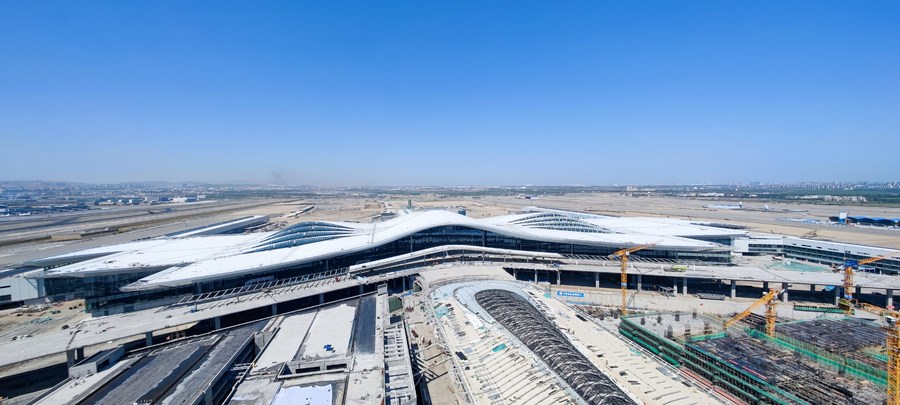
This photo taken with a mobile phone on June 17, 2023 shows a view of the Urumqi Diwopu International Airport, which is undergoing reconstruction and expansion, in Urumqi, northwest China's Xinjiang Uygur Autonomous Region. (Xinhua/Ding Lei)
The flight network has to a large extent facilitated personnel exchanges and cargo movements. In the first six months of this year, the Urumqi airport handled a throughput of more than 10 million passengers. The foreign trade volume of Xinjiang reached 125.06 billion yuan (about 17.4 billion U.S. dollars) from January to May, up 85.9 percent year on year, according to Urumqi Customs.
"BLUE OCEAN" FOR COOPERATION
The C919, China's self-developed large passenger aircraft that has started regular operation between Shanghai and Chengdu, can also contribute to Urumqi's building of an aviation hub on the Belt and Road.
"The maximum flight range for C919 exceeds 5,550 km. This means C919 flights departing from Urumqi can not only fly to all cities in China but also to Central Asia and even East Europe," said Wu Guanghui, chief scientist at Commercial Aircraft Corporation of China, Ltd. and an academician with the Chinese Academy of Engineering.
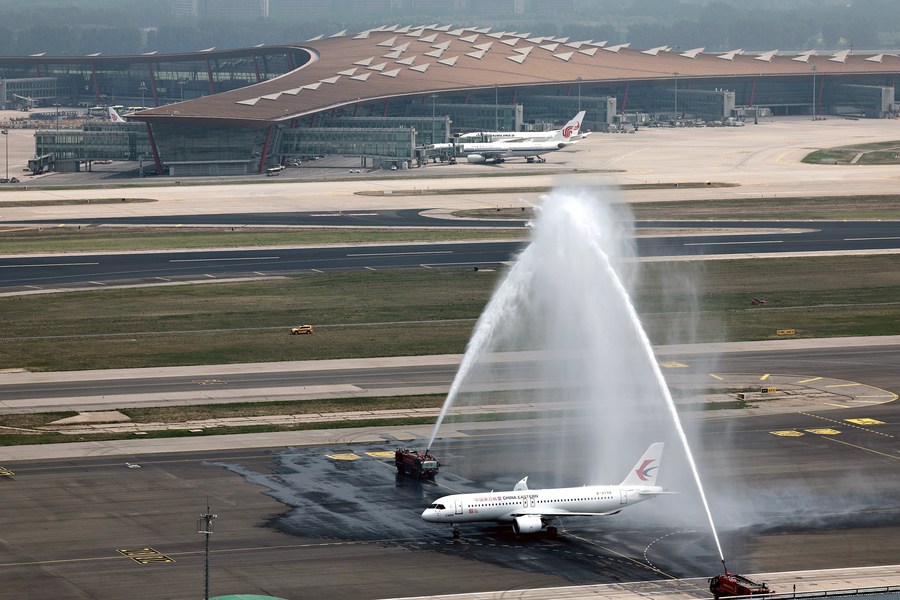
A C919 large passenger aircraft, China's first self-developed trunk jetliner, is greeted with a water salute after touching down at Beijing Capital International Airport in Beijing, capital of China, May 28, 2023. (Photo by Wang Yang/Xinhua)
During this forum, the Silk Road Civil Aviation Cooperation Alliance was also inaugurated. This alliance comprises various members including airlines, civil airports, aircraft and equipment manufacturers, cultural and tourism enterprises, financial institutions and trade associations from China and other countries and regions along the Silk Road.
Initiated by the China Air Transport Association (CATA), the alliance aims to further deepen civil aviation cooperation among BRI participants and will take aviation business as a link to promote cooperation among multiple parties, said Wang Changshun, chairman of CATA.
During the forum, executives from domestic and international airline companies, such as China Southern Airlines and China Eastern Airlines, made commitments to support the development of Urumqi as an aviation hub on the Belt and Road.
"We strongly support the construction of Urumqi international aviation hub and are willing to establish close cooperative relations with the Urumqi airport," said Badral Erdenebaatar, general manager of the Beijing branch office of MIAT Mongolian Airlines.
(Xinhua reporters Hao Yu, Zhang Yu, Zhang Xiaocheng also contributed to the story; Video reporter: Zhang Xiaocheng; Video editors: Zhang Li, Hui Peipei, Lin Lin and Liu Ruoshi)
You May Like
-
Economic Watch: Belt and Road Initiative fosters shared grow...
China and Central and Eastern European Countries (CEECs) have just concluded a key trade and commerce expo in Ningbo, east China, unleashing new potential for...
InKunming 2023-05-22 -
Belt and Road project staff in Malta receive on-site traditi...
"It is amazing," said 34-year-old Mario Borg after receiving a neck massage from a doctor of the 18th Chinese medical team for Malta.
InKunming 2023-05-18 -
Xi Focus-Closeup: A transformative speech that gave rise to ...
The Belt and Road Initiative (BRI) has been one of the most talked-about buzzwords in international cooperation over the past few years. While many people know ...
InKunming 2023-05-17 -
Chinese youths devoted to BRI projects in Bangladesh
In recent years, Bangladesh has actively participated in the Belt and Road Initiative (BRI) and cooperated with China on many infrastructure projects.
InKunming 2023-05-09 -
China's water-saving agriculture technology benefits BRI cou...
Muhammad Ali Raza, a Pakistani doctor, has recently been working on an experiment on the utilization of plastic mulch and drip irrigation in cereal-legume inter...
InKunming 2023-05-04 -
Interview: China's BRI key contributor to global economic gr...
China-proposed Belt and Road Initiative (BRI) has become a key contributor to global economic growth and poverty reduction in the post-COVID-19 pandemic era, a ...
InKunming 2023-04-26 -
Bangladesh's first green fertilizer factory built under Chin...
With machines roaring, the construction work of Bangladesh's Ghorashal-Polash Urea Fertilizer Project (GPUFP), set to be the country's largest and first-ever gr...
InKunming 2023-04-17 -
BRI projects deliver promising future for Malaysian youth
Major infrastructure projects have been launched in Malaysia under the Belt and Road Initiative (BRI), which have boosted development and job creation along the...
InKunming 2023-04-10 -
Interview: China's BRI key to shaping Africa's future prospe...
Erastus Mwencha, former deputy chairperson of the AU Commission said that BRI projects are directly tied to Africa's quest for integration, enhanced cross-borde...
InKunming 2023-04-04 -
Interview: Chairman of Energy China hails win-win potential ...
Song Hailiang firmly believes in the benefits of the Belt and Road Initiative (BRI), viewing it as a path of development, win-win cooperation and hope for all t...
InKunming 2023-04-04
